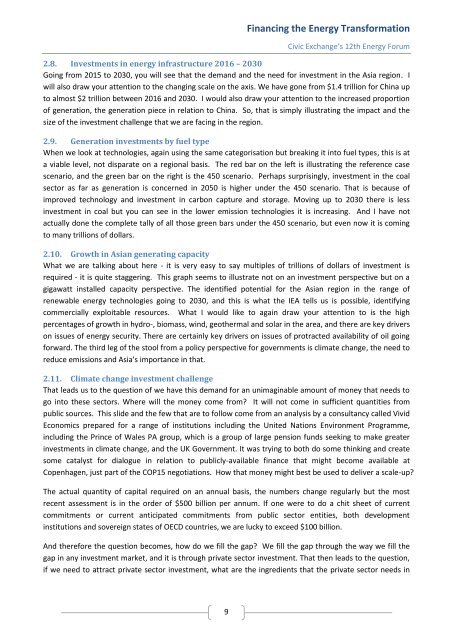Financing the Energy Transformation - Civic Exchange
Financing the Energy Transformation - Civic Exchange
Financing the Energy Transformation - Civic Exchange
Create successful ePaper yourself
Turn your PDF publications into a flip-book with our unique Google optimized e-Paper software.
<strong>Financing</strong> <strong>the</strong> <strong>Energy</strong> <strong>Transformation</strong><strong>Civic</strong> <strong>Exchange</strong>’s 12th <strong>Energy</strong> Forum2.8. Investments in energy infrastructure 2016 – 2030Going from 2015 to 2030, you will see that <strong>the</strong> demand and <strong>the</strong> need for investment in <strong>the</strong> Asia region. Iwill also draw your attention to <strong>the</strong> changing scale on <strong>the</strong> axis. We have gone from $1.4 trillion for China upto almost $2 trillion between 2016 and 2030. I would also draw your attention to <strong>the</strong> increased proportionof generation, <strong>the</strong> generation piece in relation to China. So, that is simply illustrating <strong>the</strong> impact and <strong>the</strong>size of <strong>the</strong> investment challenge that we are facing in <strong>the</strong> region.2.9. Generation investments by fuel typeWhen we look at technologies, again using <strong>the</strong> same categorisation but breaking it into fuel types, this is ata viable level, not disparate on a regional basis. The red bar on <strong>the</strong> left is illustrating <strong>the</strong> reference casescenario, and <strong>the</strong> green bar on <strong>the</strong> right is <strong>the</strong> 450 scenario. Perhaps surprisingly, investment in <strong>the</strong> coalsector as far as generation is concerned in 2050 is higher under <strong>the</strong> 450 scenario. That is because ofimproved technology and investment in carbon capture and storage. Moving up to 2030 <strong>the</strong>re is lessinvestment in coal but you can see in <strong>the</strong> lower emission technologies it is increasing. And I have notactually done <strong>the</strong> complete tally of all those green bars under <strong>the</strong> 450 scenario, but even now it is comingto many trillions of dollars.2.10. Growth in Asian generating capacityWhat we are talking about here - it is very easy to say multiples of trillions of dollars of investment isrequired - it is quite staggering. This graph seems to illustrate not on an investment perspective but on agigawatt installed capacity perspective. The identified potential for <strong>the</strong> Asian region in <strong>the</strong> range ofrenewable energy technologies going to 2030, and this is what <strong>the</strong> IEA tells us is possible, identifyingcommercially exploitable resources. What I would like to again draw your attention to is <strong>the</strong> highpercentages of growth in hydro-, biomass, wind, geo<strong>the</strong>rmal and solar in <strong>the</strong> area, and <strong>the</strong>re are key driverson issues of energy security. There are certainly key drivers on issues of protracted availability of oil goingforward. The third leg of <strong>the</strong> stool from a policy perspective for governments is climate change, <strong>the</strong> need toreduce emissions and Asia’s importance in that.2.11. Climate change investment challengeThat leads us to <strong>the</strong> question of we have this demand for an unimaginable amount of money that needs togo into <strong>the</strong>se sectors. Where will <strong>the</strong> money come from? It will not come in sufficient quantities frompublic sources. This slide and <strong>the</strong> few that are to follow come from an analysis by a consultancy called VividEconomics prepared for a range of institutions including <strong>the</strong> United Nations Environment Programme,including <strong>the</strong> Prince of Wales PA group, which is a group of large pension funds seeking to make greaterinvestments in climate change, and <strong>the</strong> UK Government. It was trying to both do some thinking and createsome catalyst for dialogue in relation to publicly-available finance that might become available atCopenhagen, just part of <strong>the</strong> COP15 negotiations. How that money might best be used to deliver a scale-up?The actual quantity of capital required on an annual basis, <strong>the</strong> numbers change regularly but <strong>the</strong> mostrecent assessment is in <strong>the</strong> order of $500 billion per annum. If one were to do a chit sheet of currentcommitments or current anticipated commitments from public sector entities, both developmentinstitutions and sovereign states of OECD countries, we are lucky to exceed $100 billion.And <strong>the</strong>refore <strong>the</strong> question becomes, how do we fill <strong>the</strong> gap? We fill <strong>the</strong> gap through <strong>the</strong> way we fill <strong>the</strong>gap in any investment market, and it is through private sector investment. That <strong>the</strong>n leads to <strong>the</strong> question,if we need to attract private sector investment, what are <strong>the</strong> ingredients that <strong>the</strong> private sector needs in9
















